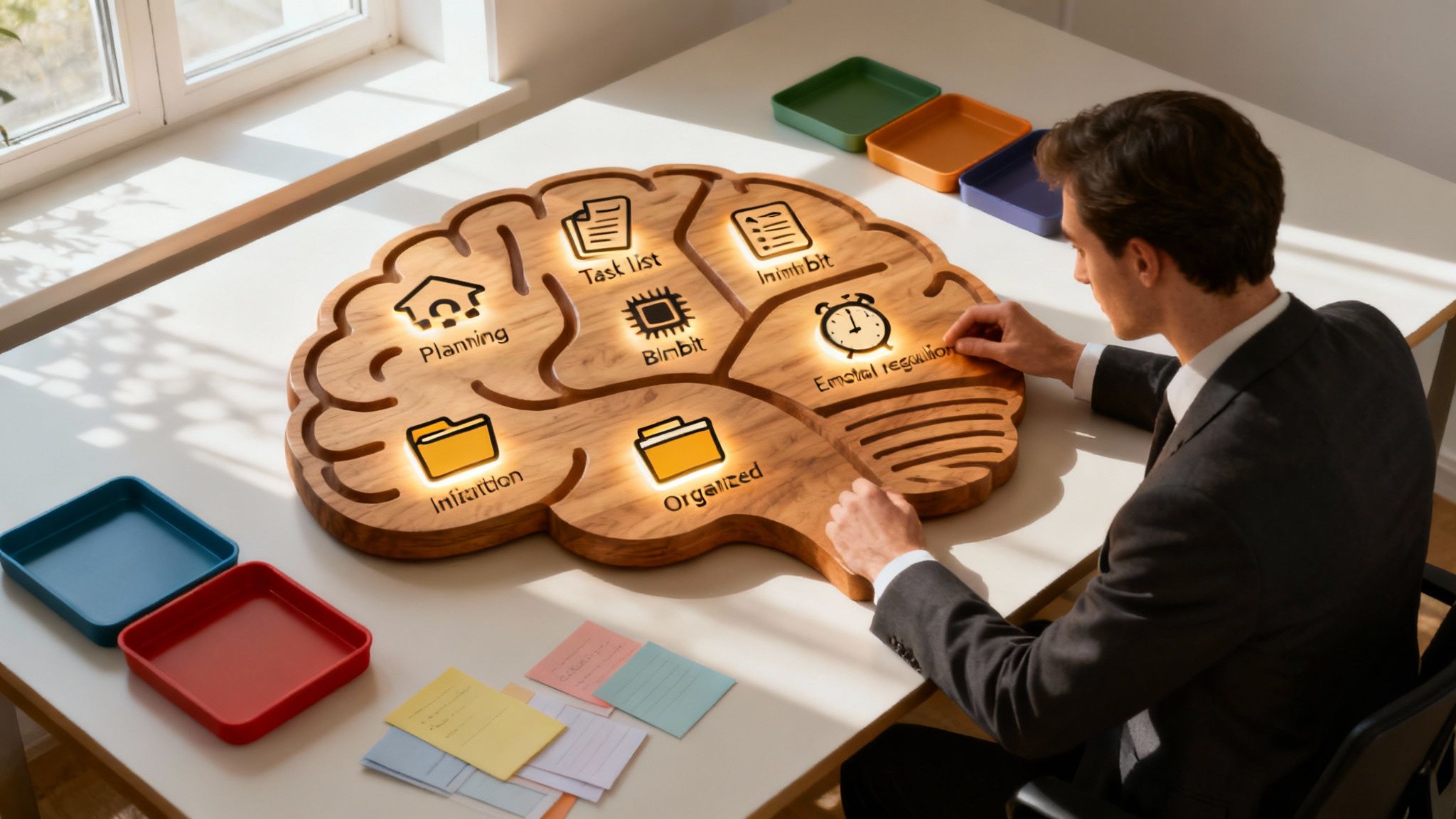ADHD is associated with hyperactivity and impulsivity and often thought of as a condition that only affects school-aged boys—running around a classroom, displaying aggression, and being unable to sit still for long periods. But this is not what ADHD looks like for everyone.
While ADHD can undoubtedly manifest in such ways, ADHD affects people of all ages and genders and doesn't necessarily cause physical hyperactivity.
If you mainly struggle with task completion, organization, time management, or distractibility, you may have predominantly inattentive ADHD (ADHD-PI).
Too long; didn't read
- There are three types of ADHD: predominantly inattentive (ADHD-PI), predominantly hyperactive-impulsive (ADHD-HI), and combined type (ADHD-C).
- There are nine recognized symptoms of ADHD-PI, including forgetfulness, attention dysregulation, and organization problems.
- You don't need to have every ADHD symptom to be diagnosed.
- ADHD-PI can be treated with medication and therapy.
What is inattentive ADHD?
There are three types of ADHD:
- Predominantly inattentive: ADHD-PI
- Predominantly hyperactive-impulsive: ADHD-HI
- Combined: ADHD-C
These subtypes are often called presentations of ADHD, highlighting that people can move from one kind of ADHD to another over their lifetime.1
According to the DSM-5, the fifth edition of the Diagnostic and Statistical Manual of Mental Disorders, there are nine symptoms of ADHD-PI.4
Symptoms of inattentive ADHD:
- Not paying close attention to tasks
- Being easily distracted
- Missing small details when completing tasks
- Looking like you're not listening when spoken to
- Leaving projects and tasks unfinished, including reading instructions and directions
- Finding it difficult to organize things and manage one’s time
- Frequently losing things
- Avoiding tasks that require sustained mental effort
- Forgetfulness, including forgetting to do daily tasks and chores
Why is the inattentive subtype go underdiagnosed?
Inattentive ADHD often remains undiagnosed, especially in girls and women, because of a bias toward hyperactive symptoms. Additionally, many signs of the inattentive subtype can be characteristic of other mental health conditions, so it's not always as clear whether ADHD is the sole cause.
How does inattentive ADHD manifest in adulthood?
Relationships with others
ADHD-PI can manifest in personal relationships with family, friends, or partners. Someone with inattentive ADHD may be forgetful about doing household chores, put important things off, or arrive late to family events.
A common symptom experienced by people with inattentive-type ADHD is rejection-sensitive dysphoria (RSD), where someone feels intense emotional pain from real or perceived rejection. They may also experience severe anxiety at the possibility of being rejected.
People with RSD might feel like their partner is always mad at them, which can lead to conflict. Someone with RSD might also be told they're taking things "too personally", which can create doubts or make them less willing to express their genuine emotions.
Professional life
People with ADHD-PI often experience certain difficulties at work, like an inability to complete tasks on time, forgetting to do some things, or putting off time-consuming tasks, like writing reports or filling in spreadsheets.
In some cases, undiagnosed or untreated inattentive ADHD can eventually lead to job instability. Therefore, people with ADHD-PI may want to consider careers that align with their qualities or ask for reasonable adjustments at work.
How is inattentive-type ADHD diagnosed in adults?
According to DSM-5, a person may have ADHD-PI if they experience five to six of the nine symptoms listed above. This also depends on a person’s age.
For adults, five symptoms must present in two or more settings—like at home and work—and affect the quality of social interactions, home life, or work.
Step 1: Talking to a doctor
Talking to a primary healthcare provider is usually the first step of diagnosis. Healthcare providers and mental health professionals may thoroughly assess the patient's history of ADHD symptoms and ask permission to consult family members or friends to gain more relevant information.
Step 2: Evaluation and testing
Patients may be asked to undergo psychological assessments to examine various cognitive functions and skills, such as:
- Working memory
- Reasoning skills
- Attention and concentration
- Organization and planning
Step 3: Ruling out contraindications
During an assessment, it's essential to rule out other conditions that can lead to symptoms similar to ADHD, including autism, anxiety, and depression—to name a few. These conditions can also exist alongside ADHD, which would be considered before an official diagnosis.
Patients may also be asked whether they use alcohol or other substances to determine the appropriate treatment route.2
Treatment for inattentive ADHD
ADHD cannot be cured; however, it can be managed effectively through medication and psychotherapy.
Medication
Stimulants, like methylphenidate and amphetamine-based medications, are often the first line of treatment for ADHDers. They can be particularly effective for inattentive ADHDers because they increase the brain's transfer of dopamine-related chemicals.
Medications help to provide energy, reduce ADHD fatigue, and increase focus for ADHDers. Nonstimulants, like atomoxetine-based medication, can be practical alternatives to stimulants if stimulants are not effective or if you experience side effects.3 Talk to your healthcare provider for more information.
Cognitive behavioral therapy
Psychotherapy techniques, especially cognitive behavioral therapy (CBT), are often used to treat inattentive ADHDers. CBT works to modify behaviors and reduce thoughts that make ADHD symptoms worse.
Cognitive behavioral therapy can effectively treat inattentive ADHD in the following ways:
- Cognitive restructuring: Replacing unhelpful beliefs with more self-affirming ideas. By identifying and challenging negative thoughts, adults with ADHD can learn to think more positively and realistically.
- Symptom management: Introducing strategies to help with memory, organization, and planning skills to help ADHDers manage daily tasks and responsibilities.
- Resource recommendations: Providing tools and resources to help them cope, including physical aids such as organizational tools or mental techniques such as mindfulness.
- Improving self-talk: Identifying and eliminating negative self-talk to improve self-esteem and reduce symptoms by learning to recognize and challenge self-critical thoughts.
Final thoughts
Inattentive-type ADHD (ADHD-PI) is characterized by symptoms such as forgetfulness and inattention. It's often underdiagnosed - especially in women - and can complicate personal and professional aspects of life.
If you suspect you have inattentive ADHD, speak with your healthcare provider at your next appointment. Don't hesitate to seek help and support — you deserve to live your best life!
-
Sources
1 StatPearl | Attention Deficit Hyperactivity Disorder
2 Child and Adolescent Psychiatric Clinics of North America | ADHD and Substance Use Disorders in Young People: Considerations for Evaluation, Diagnosis, and Pharmacotherapy
3 Research in Developmental Disabilities | A systematic review of the use of atomoxetine for management of comorbid anxiety disorders in children and adolescents with attention-deficit hyperactivity disorder
4 American Psychiatric Association | Diagnostic and statistical manual of mental disorders (5th ed.)








